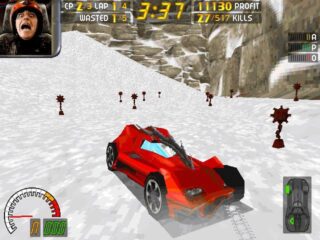Racing Destruction Set, released in 1985 for the Commodore 64 by Electronic Arts, is customizable combat racing game for 2 players. It was a remarkably advanced racing game for its time, co-designed by Rick Koenig, Dave Warhol and Connie Goldman. While it may look like a straightforward top-down racer at first glance, the game hid a surprising level of depth and creativity, setting it apart from other driving titles of the era.
At its core, Racing Destruction Set offered players a wide range of customization options that were nearly unheard of in 8-bit games. Players could choose from different types of vehicles — from dune buggies to formula cars, or even lunar rovers — and equip them with various features like high-traction tires, nitro boosts, or even landmines. The game didn't just simulate racing; it let you embrace chaos. You could race to win, or simply aim to destroy your opponents by forcing them off cliffs or launching into jumps at unsafe speeds.
What really made the game stand out, however, was the track editor. Players could design their own race tracks from scratch, choosing terrain types, slopes, banked turns, and jumps. The inclusion of gravity settings was another wild twist — you could race under Earth, Moon, or even Jupiter gravity, each dramatically affecting the physics and handling. These kinds of sandbox elements helped make the game endlessly replayable and gave it an early taste of what modern gamers might call user-generated content.
The graphics, while modest by today's standards, were effective and colorful, with smooth scrolling and a clear top-down perspective. The split-screen two-player mode was another highlight, allowing friends to compete or wreck each other in real time — a feature that felt ahead of its time for the Commodore 64.
Racing Destruction Set's mix of strategy, physics, and mayhem made it one of the most memorable and unique racing games of the 8-bit era. It influenced later titles that prioritized player customization and sandbox-style freedom, from Stunts to more recent games like TrackMania or the SNES hit Rock n' Roll Racing. Even decades later, it remains a strong example of how technical limitations can inspire creative, player-driven gameplay.














